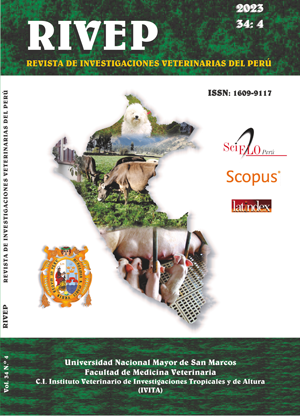Comparisons of the Fourier transform infrared spectroscopy (FTIR), colorimetric parameters and percentage of medullation in vicuña fibre
DOI:
https://doi.org/10.15381/rivep.v34i4.25953Keywords:
vicuna, FTIR spectra, colorimetry, colour intensity, type of medullationAbstract
The aim of this research was to compare vicuña fibre by the Fourier transform infrared (FTIR) spectroscopy, determine the colorimetric parameters and the percentages of medullation in vicuña fibre from Puno and Apurímac (Peru). Luminosity (L*), colour intensity or purity (C*) and hue (H*) were characterized by colorimetry. These parameters demonstrate a variability of colour and tonality in the vicuña fleece. The FTIR spectra in fibre from vicuñas from Puno and Apurimac overlap, confirming a similar chemical profile in the fibre structure. The percentage of total medullation is different according to the origin, where the vicuñas of the Community of Toma (Puno) have higher percentage of medulation (5.02%), while the vicuñas of the communities of Pilluni (1.65%) and Taraccasa (1.80%) of Apurimac maintain a lower percentage of medullation. Likewise, variability in the percentage of fibres with fragmented and strongly medullated mediation is observed according to the origin of the vicuñas. In conclusion, vicuñas from Puno and Apurímac show fibres with similar chemical characteristics, but with phenotypic variations in colour intensity, fibre tonality, and percentage of medullated fibres.
Downloads
Downloads
Published
Issue
Section
License
Copyright (c) 2023 Rubén Pinares, Virgilio Machaca, Franklin Lozano, Arturo Quispe, Ruth Ccopa, Bilo Calsin

This work is licensed under a Creative Commons Attribution 4.0 International License.
AUTHORS RETAIN THEIR RIGHTS:
a. Authors retain their trade mark rights and patent, and also on any process or procedure described in the article.
b. Authors retain their right to share, copy, distribute, perform and publicly communicate their article (eg, to place their article in an institutional repository or publish it in a book), with an acknowledgment of its initial publication in the Revista de Investigaciones Veterinarias del Perú (RIVEP).
c. Authors retain theirs right to make a subsequent publication of their work, to use the article or any part thereof (eg a compilation of his papers, lecture notes, thesis, or a book), always indicating the source of publication (the originator of the work, journal, volume, number and date).










